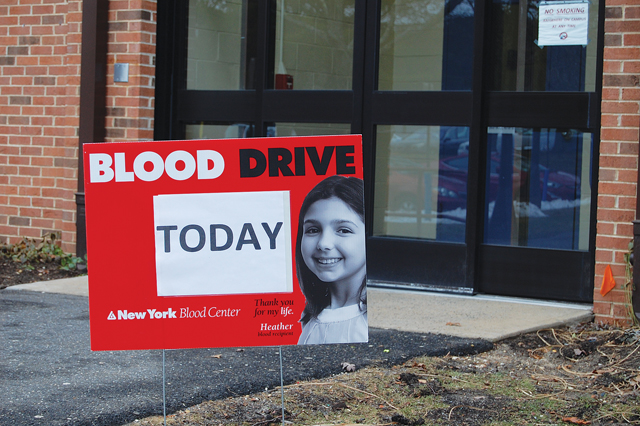Volunteers organize vital blood drive efforts frequently. But how?


Every three seconds someone in the United States needs a lifesaving blood transfusion. That means 28,800 people every day rely on donated blood supplies to survive, according to the New York Blood Center.
To meet that critical demand requires a constant uphill battle of recruiting donors to blood drives.
Lisa Lee, account manager with Long Island Blood Services, said blood drives help insure steady supplies for both emergencies and scheduled hospital procedures. One donation can typically help three to five people once it’s divided into blood, plasma and platelets, she said.
“Very rarely is it the plan,” she said of blood transfusions. “Something happens — there’s an accident, somebody becomes sick, a surgery goes awry — and people need blood. There’s very few times we get to plan for it, so we have to always be ready for it.”
How a blood drive comes together is a coordinated effort among the New York Blood Center, local businesses, a host of volunteers and, finally, the donors themselves.
The process starts with Ms. Lee and the chairperson of the local drive spending four to six weeks working together to establish a date, location, personnel, promotional material and more.
Long Island Blood Services, a division of the New York Blood Center, provides the phlebotomists who draw the blood, helps set up the event and brings snacks and juice for the donors. They also work on partnering with local businesses to offer treats to donors. For example, Snowflake Ice Cream Shoppe in Riverhead offers a free scoop of ice cream, McDonald’s provides coupons for a sandwich and Dunkin’ Donuts supplies a free doughnut.
The blood drive chairperson hangs fliers, makes phone calls, sends postcards, greets donors and helps set up and clean up the event.
“We always make home-baked goods for [donors],” said Lauren Reichel, chairwoman of the Riverhead Community Blood Drive. “We try and keep it a Riverhead community. We try to make it very family oriented … the [donors] like that little touch.”

The Riverhead Community Blood Drive is held four times a year — in March, June, September and December. The drives are spread out since donors must wait at least 56 days in between donating so their bodies can replenish the blood supply, according to the American Red Cross.
The most challenging part of the process is finding willing donors. Approximately 38 percent of the population is eligible to donate blood at any given time, according to the American Red Cross, but only 10 percent of those eligible actually do.
“Most people that donate know why it’s important,” said Barbara Swislosky, who runs the Flanders, Riverside and Northampton Community Association drives. “It’s the people that don’t donate blood who are the ones that have to learn. It saves a lot of lives.”
In 2015, 1,129 pints of blood were donated at events in Riverhead Town. There were 513 donations among the four Riverhead Community Blood Drives. Peconic Bay Medical Center hosted four drives with 167 pints donated. Other drives were held at various schools throughout the town as well as ones hosted by FRNCA, Hilton Garden Inn and Long Island Aquarium.
“All the blood collected goes to Long Island Blood Services and stays on Long Island and serves the Long Island communities,” said David Betancourt, who chairs the blood drives at PBMC.
At the end of each drive, the donations are transported to the New York Blood Center site in Westbury, where mini tubes of blood in each blood bag are removed and sent out of state for testing, Ms. Lee said. The results come back 72 hours later and then the blood is distributed to hospitals across the island.
The refrigerated blood lasts 42 days before it spoils. The difficult part, Ms. Lee said, is when a major, unpredicted event happens such as Hurricane Sandy or Sept. 11.
In those situations, the center must scramble to find extra blood, some of which may be shipped from nearby states. It’s usually after those tragic events that donors turn out in unprecedented numbers. After Sept. 11, so many people donated blood that much of it had to be frozen because it wasn’t immediately needed, Ms. Lee said.
“The most important thing is it saves lives,” Mr. Betancourt said. “It treats so many conditions out there: anemia, cancer, leukemia. There are so many reasons why blood is needed.”
Jordan Gonzalez, 20, was one of the donors at a Feb. 17 blood drive held at Suffolk County Community College.
“I do it to give back,” he said. “It’s a small sacrifice honestly. I’m an organ donor, too. Anything I have that somebody else needs that I can give, I feel like it’s my responsibility to do.”
Photo Caption: Jordan Gonzalez, 20, of Mastic Beach gives blood Feb. 17 at a blood drive held at Suffolk County Community College’s Eastern Campus. Of the 38 percent of the American population eligible to donate blood, only about 10 percent actually do so. (Credit: Nicole Smith)



